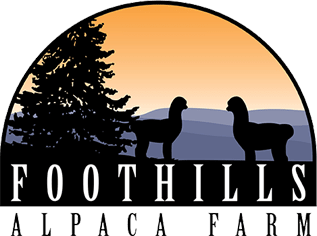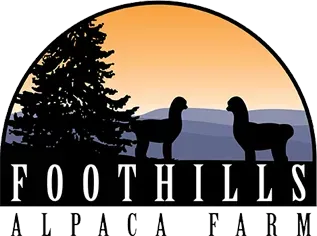Contact Info
Contact Info
Frequently Asked Questions About Alpacas & Alpaca Products
Curious about alpacas? At Foothills Alpaca Farm, we love sharing what makes these animals—and their fiber—so special. Whether you’re interested in their behavior, breeding, or the unique characteristics of alpaca products, this FAQ page covers the most common questions we hear from visitors and customers alike.
Our family farm in Pocahontas, Arkansas remains open and welcomes in-person tours by appointment. We're always here to educate, inspire, and share our passion for alpacas.

Interesting Facts About Alpacas
How long is an alpaca’s gestation?
An alpaca’s gestation period is typically about 11.5 months, or approximately 345 days on average. However, it can range from 320 to 370 days, depending on the individual alpaca and environmental factors. It's quite a long pregnancy, and alpacas usually give birth during daylight hours, often without assistance.
What is the difference between a llama and an alpaca?
While llamas and alpacas look similar, they’re quite different:
- Ears: Llamas have long banana-shaped ears; alpacas have shorter spear-shaped ears.
- Size: Llamas can weigh up to 400 lbs; alpacas average 150 lbs.
- Face: Llamas have long faces; alpacas have short, rounded, “smooshed” faces.
- Purpose: Alpacas are bred for fiber; llamas are used for packing and meat.
- Hair: Alpaca fiber is finer, softer, and more colorful than llama fleece.
- Behavior: Alpacas are herd animals; llamas are more independent and often serve as guard animals.
Do alpacas spit?
Yes—but rarely at people. Alpacas generally spit at each other to show dominance or disapproval. If you see one with raised chin, pinned-back ears, and a hard stare—back away slowly. You may be in the splash zone!
All About Alpaca Fiber & Yarn
What makes alpaca yarn so great?
Alpaca yarn is a favorite for both professional and hobbyist fiber artists because it’s:
- Extremely warm and lightweight (up to 7x warmer than sheep’s wool)
- Naturally hypoallergenic—no lanolin means it’s gentle on sensitive skin
- Durable and strong, even when spun into fine strands
- Silky and soft—it feels luxurious, not scratchy
- Resilient—naturally flame-resistant, water-repellent, and mildew-resistant
- Softer than cashmere (really—feel it to believe it!)
What types of products are made with alpaca fiber?
Alpaca fiber is used to create:
- Yarn and roving for spinning and weaving
- Socks, scarves, gloves, and hats
- Blankets, throws, and home décor
- Dryer balls and felted crafts
- Stuffed toys
All these items are available through our shop.
Alpaca Behavior & Care
Can alpacas be ridden?
No—alpacas are not meant to be ridden. They’re much smaller than llamas and are not built to support the weight of a person, even a child. Trying to ride one can harm the animal and will almost certainly result in some unpleasant spitting.
What do alpacas eat?
- Alpacas are grazing animals. Their diet typically includes:
- Grass and pasture plants
- Hay, especially during winter or drought
- Specialty grains for added nutrition
- Fresh water at all times
Their efficient digestion makes them easy on the environment and relatively inexpensive to feed.
Learn More About Alpacas & Our Products
We love answering questions and helping people learn about these amazing animals. Whether you’re looking for a new favorite pair of alpaca socks or want to understand the science behind fleece fineness, we’re here to help.

